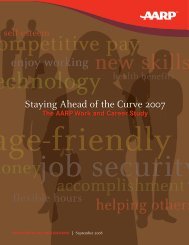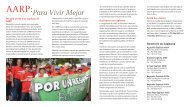The New Aging Enterprise - aarp
The New Aging Enterprise - aarp
The New Aging Enterprise - aarp
You also want an ePaper? Increase the reach of your titles
YUMPU automatically turns print PDFs into web optimized ePapers that Google loves.
<strong>The</strong> <strong>New</strong> <strong>Aging</strong> <strong>Enterprise</strong><br />
In December, 2006, AARP’s Office of Academic Affairs sponsored a conference on “<strong>The</strong><br />
<strong>New</strong> <strong>Aging</strong> <strong>Enterprise</strong>” with the Lyndon B. Johnson School of Public Affairs at the University of<br />
Texas-Austin. <strong>The</strong> conference brought together leaders and thinkers who were addressing a<br />
question heard increasingly in advanced industrialized societies: namely, how can aging societies<br />
find new sources of creativity and innovation? Will the coming of a “longevity revolution”<br />
mean a growing burden of dependency and decline? 1<br />
<strong>The</strong>re has long been a pervasive fear about population aging among many circles in the<br />
USA and Europe. 2 <strong>The</strong> French demographer Alfred Sauvy feared that an aging society would<br />
inevitably result in a “population of old people ruminating over old ideas in old houses. 3 ” One<br />
reason for gloom is a simple projection into the future of present tendencies: specifically,<br />
conditions where older people are regarded as passive consumers of public services, especially of<br />
health care and pensions. Pessimists look to the future and see bankruptcy in Social Security and<br />
Medicare, and increasing retirees without pension support in old age. <strong>The</strong>y conclude that we<br />
cannot afford an aging society because the future will bring ever-growing numbers of elders who<br />
are sick and helpless, unable to be productive members of society, and doomed to loneliness and<br />
despair.<br />
Whether older people are imagined to be on the golf course or in the nursing home, their<br />
passivity is taken for granted. Those on the Right suggest that this gloomy future demands a cut<br />
in public entitlement programs: prepare now for coming disaster. Those on the Left, if they<br />
admit a problem at all, argue instead for modest reform of public programs to meet ever-growing<br />
needs. Both Left and Right tend to agree on “needs” but they differ on how such needs could be<br />
met. Overcoming such pessimism about population aging is not easy. It will not happen until<br />
we can point to tangible examples of success and positive organizational responses -- cases that<br />
illustrate the way in which a growing older population can be an opportunity rather than a<br />
problem. <strong>The</strong> <strong>New</strong> <strong>Aging</strong> <strong>Enterprise</strong> is an attempt to describe such cases and draw from these<br />
examples some lessons for the future.<br />
<strong>The</strong> organizations analyzed here, both business and nonprofit, have thrived by responding<br />
to needs in retirement housing, health promotion, long-term care, worklife extension,<br />
volunteerism, saving and investment, and lifelong learning. Some represent consumer markets,<br />
such as housing, travel, and hospitality, while others point to ways in which an aging population<br />
can become more productive through work, volunteer roles, or reduced health care costs. All<br />
examples represent aspects of positive aging that might have been considered “utopian” but have<br />
been proven to be eminently practical because of a proven track record of success displayed in<br />
the cases examined here.<br />
Specifically, we consider profit-making corporations (Erickson, Curves, and<br />
RetirementJobs) as well as nonprofit organizations (Elderhostel, Eden Alternative, and<br />
Experience Corps). A seventh organization (Vanguard) is a hybrid. It is a business organized on<br />
terms of mutual ownership, i.e., owned by its own shareholders rather than paying profits to<br />
outside owners. All organizations profiled here have important lessons from their success,<br />
especially for the sustainability of enterprises both in business and the nonprofit sector.<br />
4










